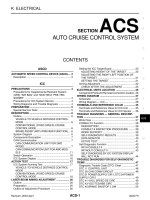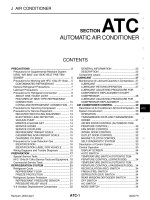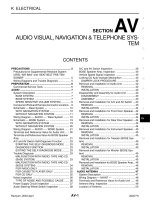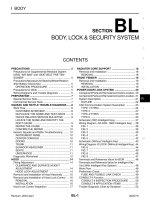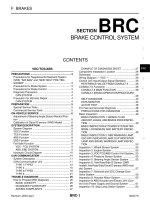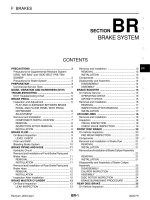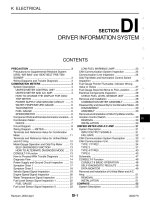HỆ THỐNG THẮNG XE TRÊN INFINITI FX35, FX45 2003
Bạn đang xem bản rút gọn của tài liệu. Xem và tải ngay bản đầy đủ của tài liệu tại đây (1.02 MB, 32 trang )
BR-1
BRAKE SYSTEM
F BRAKES
CONTENTS
C
D
E
G
H
I
J
K
L
M
SECTION BR
A
B
BR
Revision; 2004 April 2003 FX
BRAKE SYSTEM
PRECAUTIONS 3
Precautions for Supplemental Restraint System
(SRS) “AIR BAG” and “SEAT BELT PRE-TEN-
SIONER” 3
Precautions for Brake System 3
PREPARATION 4
Commercial Service Tools 4
NOISE, VIBRATION AND HARSHNESS (NVH)
TROUBLESHOOTING 5
NVH Troubleshooting Chart 5
BRAKE PEDAL 6
Inspection and Adjustment 6
PLAY AND CLEARANCE BETWEEN BRAKE
PEDAL AND FLOOR PANEL WITH PEDAL
DEPRESSED 6
ADJUSTMENT 7
Removal and Installation 7
COMPONENT PARTS LOCATION 7
REMOVAL 8
INSPECTION AFTER REMOVAL 8
INSTALLATION 8
BRAKE FLUID 9
On-Board Inspection 9
LEVEL CHECK 9
Drain and Refill 9
Bleeding Brake System 10
BRAKE PIPING AND HOSE 11
Hydraulic Circuit 11
Removal and Installation of Front Brake Piping and
Brake Hose 11
REMOVAL 11
INSTALLATION 11
Removal and Installation of Rear Brake Piping and
Brake Hose 12
REMOVAL 12
INSTALLATION 12
Inspection After Installation 12
BRAKE MASTER CYLINDER 13
On-Board Inspection 13
LEAK INSPECTION 13
Removal and Installation 13
REMOVAL 13
INSTALLATION 13
Components 13
Disassembly and Assembly 14
DISASSEMBLY 14
ASSEMBLY 14
BRAKE BOOSTER 15
On-Vehicle Service 15
OPERATING CHECK 15
AIRTIGHT CHECK 15
Removal and Installation 16
REMOVAL 17
INSPECTION AFTER REMOVAL 17
INSTALLATION 17
VACUUM LINES 18
Removal and Installation 18
Inspection 18
VISUAL INSPECTION 18
CHECK VALVE INSPECTION 19
FRONT DISC BRAKE 20
On-Vehicle Inspection 20
PAD WEAR INSPECTION 20
Components 20
Removal and Installation of Brake Pad 21
REMOVAL 21
INSTALLATION 21
Removal and Installation of Brake Caliper Assembly
21
REMOVAL 21
INSTALLATION 21
Disassembly and Assembly of Brake Caliper
Assembly 22
DISASSEMBLY 22
CALIPER INSPECTION 23
ASSEMBLY 23
DISC ROTOR INSPECTION 24
BRAKE BURNISHING PROCEDURE 24
REAR DISC BRAKE 25
On-Vehicle Inspection 25
BR-2
Revision; 2004 April 2003 FX
PAD WEAR INSPECTION 25
Components 25
Removal and Installation of Brake Pad 26
REMOVAL 26
INSTALLATION 26
Removal and Installation of Brake Caliper Assembly
26
REMOVAL 26
INSTALLATION 26
Disassembly and Assembly of Brake Caliper
Assembly 27
DISASSEMBLY 27
CALIPER INSPECTION 27
ASSEMBLY 28
DISC ROTOR INSPECTION 29
BRAKE BURNISHING PROCEDURE 29
SERVICE DATA AND SPECIFICATIONS (SDS) 31
General Specifications 31
Brake Pedal 31
Brake Booster 31
Check Valve 31
Front Disc Brake 31
Rear Disc Brake 32
PRECAUTIONS
BR-3
C
D
E
G
H
I
J
K
L
M
A
B
BR
Revision; 2004 April 2003 FX
PRECAUTIONS PFP:00001
Precautions for Supplemental Restraint System (SRS) “AIR BAG” and “SEAT
BELT PRE-TENSIONER”
AFS001Z6
The Supplemental Restraint System such as “AIR BAG” and “SEAT BELT PRE-TENSIONER”, used along
with a front seat belt, helps to reduce the risk or severity of injury to the driver and front passenger for certain
types of collision. This system includes seat belt switch inputs and dual stage front air bag modules. The SRS
system uses the seat belt switches to determine the front air bag deployment, and may only deploy one front
air bag, depending on the severity of a collision and whether the front occupants are belted or unbelted.
Information necessary to service the system safely is included in the SRS and SB section of this Service Man-
ual.
WARNING:
● To avoid rendering the SRS inoperative, which could increase the risk of personal injury or death
in the event of a collision which would result in air bag inflation, all maintenance must be per-
formed by an authorized NISSAN/INFINITI dealer.
● Improper maintenance, including incorrect removal and installation of the SRS, can lead to per-
sonal injury caused by unintentional activation of the system. For removal of Spiral Cable and Air
Bag Module, see the SRS section.
● Do not use electrical test equipment on any circuit related to the SRS unless instructed to in this
Service Manual. SRS wiring harnesses can be identified by yellow and/or orange harnesses or
harness connectors.
Precautions for Brake System AFS001MQ
● Recommended fluid is brake fluid “DOT 3”.
● Do not reuse drained brake fluid.
● Be careful not to splash brake fluid on painted areas.
● To clean or wash all parts of master cylinder, disc brake caliper and wheel cylinder, use clean brake fluid.
● Do not use mineral oils such as gasoline or kerosene. They will ruin rubber parts of the hydraulic system.
● Use flare nut wrench when removing and installing brake tube.
● Always check tightening torque when installing brake lines.
● Before working, turn ignition switch to OFF and disconnect con-
nectors for ABS actuator and electric unit (control unit) or battery
terminals.
● Burnish the brake contact surfaces after refinishing or replacing
drums or rotors, after replacing pads or linings, or if a soft pedal
occurs at very low mileage.
Refer to BR-24, "
BRAKE BURNISHING PROCEDURE" .
WARNING:
● Clean brake pads and shoes with a waste cloth, then wipe
with a dust collector.
SBR686C
BR-4
PREPARATION
Revision; 2004 April 2003 FX
PREPARATION PFP:00002
Commercial Service Tools AFS001MR
Tool name Description
1. Flare nut crowfoot
a:10 mm (0.39 in) / 12 mm (0.47 in)
2. Torque wrench
Removing and installing each brake
piping
Power tool
Removing front and rear caliper
assembly, tires
S-NT360
PBIC0190E
PBIC0191E
NOISE, VIBRATION AND HARSHNESS (NVH) TROUBLESHOOTING
BR-5
C
D
E
G
H
I
J
K
L
M
A
B
BR
Revision; 2004 April 2003 FX
NOISE, VIBRATION AND HARSHNESS (NVH) TROUBLESHOOTING PFP:00003
NVH Troubleshooting Chart AFS001MS
Use the chart below to help you find the cause of the symptom. If necessary, repair or replace these parts.
×: Applicable
Reference page
BR-20, BR-25
BR-20, BR-25
BR-20, BR-25
—
—
BR-24
, BR-29
—
—
—
BR-24
, BR-29
—
NVH in PR section
NHV in RFD section
NVH in FAX, RAX and FSU, RSU section
NVH in WT section
NVH in WT section
NVH in RAX section
NVH in PS section
Possible cause and
SUSPECTED PARTS
Pads - damaged
Pads - uneven wear
Shims damaged
Rotor imbalance
Rotor damage
Rotor runout
Rotor deformation
Rotor deflection
Rotor rust
Rotor thickness variation
Drum out of round
PROPELLER SHAFT
DIFFERENTIAL
AXLE AND SUSPENSION
TIRES
ROAD WHEEL
DRIVE SHAFT
STEERING
Symptom BRAKE
Noise ××× ×× ×××
×
×
Shake ×××××
×
×
Shimmy, Judder ××××××× ××× ×
BR-6
BRAKE PEDAL
Revision; 2004 April 2003 FX
BRAKE PEDAL PFP:46501
Inspection and Adjustment AFS001MT
PLAY AND CLEARANCE BETWEEN BRAKE PEDAL AND FLOOR PANEL WITH PEDAL
DEPRESSED
1. Check brake pedal height from dash floor panel.
2. Adjust height referring to the following specifications.
SFIA1450E
H
Brake pedal free height (from dash panel top sur-
face)
161.5 − 171.5 mm (6.36 − 6.75 in)
D
Brake pedal depressed height [under a force of
490 N (50 kg, 110 lb) with engine running]
More than 80 mm (3.15 in)
C
Clearance between bracket and the threaded end
of stop lamp switch or ASCD cancel switch (or
brake switch)
0.74 − 1.96 mm (0.0291 − 0.0772 in)
A Pedal play 3 − 11 mm (0.12 − 0.43 in)
BRAKE PEDAL
BR-7
C
D
E
G
H
I
J
K
L
M
A
B
BR
Revision; 2004 April 2003 FX
ADJUSTMENT
1. Loosen stop lamp switch and ASCD cancel switch (or brake
switch) by turning it counterclockwise by 45°.
2. Loosen lock nut (A) on input rod, then rotate input rod to set
pedal to the specified height, and tighten lock nut (A).
CAUTION:
Make sure the threaded end of input rod stays inside clevis.
3. With pedal pulled and held by hand, press stop lamp switch and
ASCD cancel switch (or brake switch) until its threaded end con-
tacts stopper rubber.
4. With the threaded end of stop lamp switch and ASCD cancel
switch (or brake switch) contacting stopper rubber, rotate switch
clockwise by 45° to secure.
CAUTION:
Make sure that the clearance (C) between stopper rubber
and threaded end of stop lamp switch and ASCD cancel
switch (or brake switch) is within the standard.
5. Check pedal play.
CAUTION:
Make sure that stop lamps go off when pedal is released.
6. Start engine to check brake pedal depressed height.
Removal and Installation AFS001MU
COMPONENT PARTS LOCATION
Lock nut (A) :
Refer to BR-16, "
Removal and Installation"
SFIA0160E
SFIA1140E
BR-8
BRAKE PEDAL
Revision; 2004 April 2003 FX
REMOVAL
1. Remove front kick plate (driver side). EI-39, "KICKING PLATE" .
2. Remove dash side finisher (driver side). EI-38, "
DASH SIDE FINISHER" .
3. Remove instrument lower panel (driver side). IP-18, "
INSTRUMENT PASSENGER LOWER PANEL" .
4. Remove steering column assembly. Refer to PS-12, "
Removal and Installation" .
5. Remove stop lamp switch and ASCD cancel switch (or brake switch) from pedal assembly.
6. Remove snap pin and clevis pin from brake booster clevis.
7. Remove mounting nuts and bolts from bracket, and remove
pedal assembly from the vehicle.
INSPECTION AFTER REMOVAL
● Check that the rivets in the upper part of brake pedal are not
deformed.
● Make sure sub bracket and slide plate are at least 4 mm (0.16
in) apart.
● Check brake pedal for bend, damage, and cracks on the welded
parts. Replace the applicable part if a failure is detected.
● Check clevis pin and resin stopper for damage and deformation.
If a failure is detected, replace clevis pin.
INSTALLATION
Paying attention to the following items, install in the reverse order of removal.
● After installing brake pedal assembly to the vehicle, adjust brake pedal height.
1. Clevis pin 2. Brake pedal assembly 3. Stopper rubber
4. Pedal pad 5. ASCD cancel switch (Models with ASCD)
Brake switch (Models with ACC)
6. Stop lamp switch
7. Clip
SFIA0159E
PFIA0223E
SBR997
BRAKE FLUID
BR-9
C
D
E
G
H
I
J
K
L
M
A
B
BR
Revision; 2004 April 2003 FX
BRAKE FLUID PFP:KN100
On-Board Inspection AFS001MV
LEVEL CHECK
● Make sure the fluid level in reservoir tank is within the standard
(between MAX and MIN lines).
● Visually check around reservoir tank for fluid leaks.
● If fluid level is excessively low, check brake system for leaks.
● If brake warning lamp remains illuminated after parking lever is
released, check brake system for fluid leakage.
Drain and Refill AFS001MW
CAUTION:
● Refill with new brake fluid “DOT3”.
● Do not reuse drained brake fluid.
● Do not let brake fluid splash on the painted surfaces of the body. This might damage the paint, so
when splashing it, immediately wipe off the area and wash away with water.
● Before servicing, disconnect actuator connector or battery negative cable.
1. Connect a vinyl tube to each bleed valve.
2. Depress brake pedal, loosen each bleed valve, and gradually
remove brake fluid.
3. Make sure there is no foreign material in reservoir tank, and refill
with new brake fluid.
4. Rest foot on brake pedal. Loosen bleed valve. Slowly depress
pedal until it stops. Tighten bleed valve. Release brake pedal.
Repeat this process a few times, then pause to add new brake
fluid to master cylinder. Continue until new brake fluid flows out.
Bleed Air. Refer to BR-10, "
Bleeding Brake System" .
SFIA1032E
BRA0007D
SBR995
BR-10
BRAKE FLUID
Revision; 2004 April 2003 FX
Bleeding Brake System AFS001MX
CAUTION:
While bleeding, pay attention to master cylinder fluid level.
1. Turn ignition switch OFF and disconnect ABS actuator and electric unit (control unit) connector or battery
negative cable.
2. Connect a vinyl tube to the rear right bleed valve.
3. Fully depress brake pedal 4 to 5 times.
4. With brake pedal depressed, loosen bleed valve to let the air out, and then tighten it immediately.
5. Repeat steps 3, 4 until no more air comes out.
6. Tighten bleed valve to the specified torque. Refer to BR-20, "
Components" (front disc brake), BR-25,
"Components" (rear disc brake).
7. In steps 2 to 6 below, with master cylinder reservoir tank filled at least half way, bleed air from the front left,
rear left, and front right bleed valve, in that order.
BRAKE PIPING AND HOSE
BR-11
C
D
E
G
H
I
J
K
L
M
A
B
BR
Revision; 2004 April 2003 FX
BRAKE PIPING AND HOSE PFP:46210
Hydraulic Circuit AFS001MY
CAUTION:
● All hoses and piping (tubes) must be free from excessive bending, twisting and pulling.
● Make sure there is no interference with other parts when turning steering both clockwise and
counterclockwise.
● The brake piping is an important safety part. If a brake fluid leak is detected, always disassemble
the parts. Replace applicable part with a new one, if necessary.
● Be careful not to splash brake fluid on painted areas; it way cause paint damage. If brake fluid is
splashed on painted areas, wash it away with water immediately.
● Do not bend or twist brake hose sharply, or strongly pull it.
● When removing components, cover connections so that no dirt, dust, or other foreign matter gets
in.
● Refill with new brake fluid “ DOT 3 ”
● Do not reuse drained brake fluid.
Removal and Installation of Front Brake Piping and Brake Hose AFS001MZ
REMOVAL
1. Drain brake fluid. Refer to BR-9, "Drain and Refill" .
2. Using a flare nut wrench, remove brake tube from brake hose.
3. Remove union bolt and remove brake hose from caliper assembly.
4. Remove lock plate and remove brake hose from the vehicle.
INSTALLATION
1. Install brake hose by aligning with the protrusion on caliper
assembly, and tighten union bolt to the specified torque.
NOTE:
Do not reuse copper washer.
2. Install brake hose to brake tube, partially tighten flare nut as far
as possible by hand, then secure it to bracket with lock plate.
3. Using a flare nut wrench, tighten flare nut to the specified
torque.
4. Refill brake fluid and bleed air. Refer to BR-10, "
Bleeding Brake
System" .
SFIA1124E
SFIA1204E
BR-12
BRAKE PIPING AND HOSE
Revision; 2004 April 2003 FX
Removal and Installation of Rear Brake Piping and Brake Hose AFS001N0
REMOVAL
1. Drain brake fluid. Refer to BR-9, "Drain and Refill" .
2. Using a flare nut wrench, remove brake tube from brake hose.
3. Remove bolt.
4. Remove union bolt, and then remove brake hose from caliper assembly.
INSTALLATION
1. Install brake hose to caliper assembly positioning hole and
tighten union bolt to the specified torque.
NOTE:
Do not reuse copper washer.
2. Install brake hose to brake tube, partially tighten flare nut as far
as possible by hand, then tighten bolt to the specified torque.
3. Using a flare nut wrench, tighten flare nut to the specified
torque.
4. Refill brake fluid and bleed air. Refer to BR-10, "
Bleeding Brake
System" .
Inspection After Installation AFS001N1
CAUTION:
If a leak is detected at the connections, retighten it or, if necessary, replace the damaged part.
1. Check brake lines (tubes and hoses), and connections for fluid leaks, damage, twist, deformation, contact
with other parts, and loose connections. Replace any damage parts.
2. While depressing brake pedal under a force of 785 N (80 kg, 177 lb) with engine running for approximately
5 seconds, check for fluid leakage from each part.
: 23.5 N·m (2.4 kg-m, 17 ft-lb)
SFIA1207E
BRAKE MASTER CYLINDER
BR-13
C
D
E
G
H
I
J
K
L
M
A
B
BR
Revision; 2004 April 2003 FX
BRAKE MASTER CYLINDER PFP:46010
On-Board Inspection AFS001N2
LEAK INSPECTION
● Check for leaking in master cylinder attachment portion, reservoir tank, and brake tube connections.
Removal and Installation AFS001N3
CAUTION:
Be careful not to splash brake fluid on painted areas; it way cause paint damage. If brake fluid is
splashed on painted areas, wash it away with water immediately.
REMOVAL
1. Drain brake fluid. Refer to BR-9, "Drain and Refill" .
2. Disconnect harness connectors for fluid level sensor and pressure sensor.
3. Using a flare nut wrench, disconnect brake tube from master cylinder assembly.
4. Remove master cylinder assembly fixing nut, remove master cylinder assembly from the vehicle. Refer to
BR-16, "
Removal and Installation" .
INSTALLATION
● Install in the reverse order of removal.
– Refill brake fluid and bleed air. Refer to BR-10, "Bleeding Brake System" .
CAUTION:
● Refill with new brake fluid “DOT3”.
● Do not reuse drained brake fluid.
Components AFS001N4
SFIA1131E
BR-14
BRAKE MASTER CYLINDER
Revision; 2004 April 2003 FX
Disassembly and Assembly AFS001N5
DISASSEMBLY
CAUTION:
● Master cylinder can not be disassembly.
● Remove reservoir tank only when absolutely necessary.
1. Remove clip.
2. Remove reservoir tank and grommet from master cylinder
assembly.
ASSEMBLY
CAUTION:
● Never use mineral oil such as kerosene, gasoline during the cleaning and assembly process.
● Do not drop parts. If a part is dropped, do not use it.
1. Apply brake fluid grommet and attach to master cylinder assembly.
CAUTION:
Do not reuse grommet.
2. Install reservoir tank onto master cylinder assembly.
3. Install clip.
1. Reservoir cap 2. Strainer 13. Float
4. Reservoir tank 5. Fluid level sensor 6. Grommet
7. Master cylinder sub-assembly 8. Clip 9. Pressure sensor
10. Pressure sensor (Only ICC models)
SFIA1132E
SFIA1132E
BRAKE BOOSTER
BR-15
C
D
E
G
H
I
J
K
L
M
A
B
BR
Revision; 2004 April 2003 FX
BRAKE BOOSTER PFP:47200
On-Vehicle Service AFS001N6
OPERATING CHECK
With engine stopped, change the vacuum to the atmospheric pres-
sure by depressing brake pedal several times. Then with brake
pedal fully depressed, start engine and when the vacuum pressure
reaches the standard, make sure the clearance between brake pedal
and floor panel decreases.
CAUTION:
Depressing pedal interval is approximately 5 seconds.
AIRTIGHT CHECK
● Run engine at idle for approximately 1 minute, and stop it after
applying vacuum to booster. Depress brake pedal normally to
change the vacuum to the atmospheric pressure. Make sure dis-
tance between brake pedal and floor panel gradually increases.
● Depress brake pedal while engine is running, and stop
engine with pedal depressed. The pedal stroke should not
change after holding pedal down for 30 seconds.
CAUTION:
Depressing pedal interval is approximately 5 seconds.
BRA0037D
SBR365AA
BR-16
BRAKE BOOSTER
Revision; 2004 April 2003 FX
Removal and Installation AFS001N7
1. Reservoir tank 2. Master cylinder 3. Gasket
4. Brake pedal 5. Lock nut 6. Brake booster
SFIA1033E
BRAKE BOOSTER
BR-17
C
D
E
G
H
I
J
K
L
M
A
B
BR
Revision; 2004 April 2003 FX
REMOVAL
CAUTION:
● Be careful not to deform or bend brake piping while removing and installing brake booster.
● Replace clevis pin if it is damaged.
● Be careful not to damage brake booster stud bolt threads. If brake booster is tilted or inclined dur-
ing installation, dash panel may damage the threads.
● Attach the check valve in the correct direction.
1. Remove brake piping from brake master cylinder.
2. Remove brake master cylinder. Refer to BR-13, "
Removal and Installation" .
3. Remove vacuum hose from brake booster. Refer to BR-18, "
VACUUM LINES" .
4. Disconnect boost solenoid release switch harness connector from brake booster assembly. (ICC model)
5. Remove brake pedal attachment snap pin and clevis pin from inside the vehicle.
6. Remove nuts on brake booster and brake pedal assembly.
7. Remove brake booster assembly from dash panel.
INSPECTION AFTER REMOVAL
Output Rod Length Inspection
1. Using a handy vacuum pump, apply a vacuum of – 66.7 kPa (–
500 mmHg, –19.69 inHg) to brake booster.
2. Check output rod length.
INSTALLATION
1. Loosen lock nut to adjust input rod length so that the length B (in
the figure) satisfies the specified value.
2. After adjusting “B”, temporarily tighten lock nut to install booster
assembly to the vehicle. At this time, make sure to install a gas-
ket between booster assembly and the dash panel.
3. Connect brake pedal with clevis of input rod.
4. Install pedal bracket mounting nuts and tighten them to the
specified torque.
5. Install brake piping from brake master cylinder to ABS actuator.
Refer to BR-11, "
Hydraulic Circuit" .
6. Install master cylinder to booster assembly. Refer to BR-16, "
Removal and Installation" .
7. Adjust the height and play of brake pedal.
8. Tighten lock nut of input rod to the specified torque.
9. Refill new brake fluid and bleed air. Refer to BR-10, "
Bleeding Brake System" .
SBR208E
Standard dimension when vacuum – 66.7 kPa (– 500 mmHg, – 19.69 inHg):
15.6 − 15.9 mm (0.614 − 0.626 in)
Length “B” : 125 mm (4.92 in)
SGIA0060E
BR-18
VACUUM LINES
Revision; 2004 April 2003 FX
VACUUM LINES PFP:41920
Removal and Installation AFS001N8
CAUTION:
● Because vacuum hose contains a check valve, it must be installed in the correct direction. Refer to
the stamp or label to confirm correct installation. The brake booster will not operate normally if
hose is installed in the wrong direction.
● Insert vacuum hose for at least 24 mm (0.94 in).
● Do not use lubricating oil during assembly.
Inspection AFS001N9
VISUAL INSPECTION
Check for improper assembly, damage and deterioration.
1. Clamp 2. Vacuum hose 3. Clamp
4. Vacuum piping 5. Clamp 6. Check valve inclusion position stamp
7. Vacuum hose 8. Clamp 9. Brake booster
SFIA1134E
SBR225B
VACUUM LINES
BR-19
C
D
E
G
H
I
J
K
L
M
A
B
BR
Revision; 2004 April 2003 FX
CHECK VALVE INSPECTION
Airtightness Inspection
Use a handy vacuum pump to check.
When connected to booster side (1):
Vacuum decrease should be within 1.3 kPa
(10 mmHg, 0.39 inHg) for 15 seconds under
a vacuum of – 66.7 kPa (– 500 mmHg, –
19.69 inHg)
When connected to engine side (2):
No vacuum will be applied
SFIA0210E
BR-20
FRONT DISC BRAKE
Revision; 2004 April 2003 FX
FRONT DISC BRAKE PFP:41000
On-Vehicle Inspection AFS001RX
PAD WEAR INSPECTION
● Inspect the thickness of pad through cylinder body inspection
hole. Use a scale for inspection if necessary.
Components AFS001RY
Standard thickness : 9.5 mm (0.374 in)
Repair limit thickness : 2.0 mm (0.079 in)
BRA0010D
1. Union bolt 2. Copper washer 3. Brake hose
4. Sliding pin bolt 5. Sliding pin 6. Cap
7. Bleed valve 8. Cylinder body 9. Sliding pin boot
10. Piston seal 11. Piston 12. Piston boot
13. Torque member 14. Inner shim cover 15. Inner shim
16. Inner pad 17. Pad retainer (Upper) 18. Pad retainer (Lower)
19. Outer pad 20. Outer shim 21. Washer
22. Torque member bolt
SFIA1135E
FRONT DISC BRAKE
BR-21
C
D
E
G
H
I
J
K
L
M
A
B
BR
Revision; 2004 April 2003 FX
WARNING:
Clean dust on caliper and brake pad with a vacuum dust collector to minimize the hazard of airborne
particles or other materials.
CAUTION:
● While removing cylinder body never depress brake pedal because piston will pop out.
● It is not necessary to remove bolts on torque member and brake hose except for disassembly or
replacement of caliper assembly. In this case, hang cylinder body with a wire so as not to stretch
brake hose.
● Do not damage piston boot.
● If any shim is subject to serious corrosion, replace it with a new one.
● Always replace shims and shim covers as a set when replacing brake pads.
● Burnish brake contact surface after refinishing or replacing rotors, after replacing pads, or it a soft
pedal occurs at very low mileage. Refer to BR-24, "
BRAKE BURNISHING PROCEDURE" .
Removal and Installation of Brake Pad AFS001RZ
REMOVAL
1. Remove tires from vehicle with power tool.
2. Remove lower sliding pin bolt.
3. Suspend cylinder body with a wire and remove pad and shim from torque member.
INSTALLATION
1. Attach inner shim and shim cover to inner pad, and outer shim to outer pad.
2. Push piston in so that pad is firmly installed and mount cylinder body to torque member.
NOTE:
Using a disc brake piston tool (commercial service tool), etc., makes it easier to push in piston.
CAUTION:
By pushing in piston, brake fluid returns to master cylinder reservoir tank. Watch the level of the
surface of reservoir tank.
3. Attach pat retainer to torque member.
CAUTION:
When attaching pad retainer, attach it firmly so that it does
not float up higher than torque member, as shown in the fig-
ure.
4. Install lower sliding pin bolt and tighten it to the specified torque.
5. Check brake for drag.
6. Attach tires to the vehicle.
Removal and Installation of Brake Caliper Assembly AFS001S0
REMOVAL
1. Remove tires from vehicle with power tool.
2. Drain brake fluid. Refer to BR-9, "
Drain and Refill" .
3. Remove union bolts and torque member bolts, and remove brake caliper assembly from the vehicle.
4. Remove disc rotor.
INSTALLATION
CAUTION:
● Refill with new brake fluid “DOT3”
● Do not reuse drained brake fluid.
1. Install disc rotor.
PFIA0273E
BR-22
FRONT DISC BRAKE
Revision; 2004 April 2003 FX
2. Install caliper assembly to the vehicle, and tighten bolts to the
specified torque.
CAUTION:
When attaching caliper assembly to the vehicle, wipe any
oil off knuckle spindle, washers and caliper assembly
attachment surfaces.
3. Install brake hose to brake caliper assembly, and tighten union
bolt to the specified torque.
CAUTION:
● Do not reuse copper washers for union bolt.
● Attach brake hose to caliper assembly together with
union bolt and washers.
4. Refill new brake fluid and bleed air. Refer to BR-10, "
Bleeding Brake System" .
5. Attach tires to the vehicle.
Disassembly and Assembly of Brake Caliper Assembly AFS001S1
DISASSEMBLY
1. Remove sliding pin bolt, and then remove the pad, shim, shim cover, and pad retainer from the torque
member.
2. Remove sliding pins and sliding pin boots from torque member.
3. Place a wooden block as shown in the figure, and blow air from
union bolt mounting hole to remove pistons and piston boots.
CAUTION:
Do not get your fingers caught in piston.
4. Using a flat-bladed screwdriver, remove piston seal from cylin-
der body.
CAUTION:
Be careful not to damage cylinder inner wall.
SFIA1205E
SFIA1204E
MAA0272D
SFIA1301E
FRONT DISC BRAKE
BR-23
C
D
E
G
H
I
J
K
L
M
A
B
BR
Revision; 2004 April 2003 FX
CALIPER INSPECTION
Cylinder Body
CAUTION:
● Use new brake fluid for cleaning. Do not use mineral oils such as gasoline or kerosene.
● Check inside surface of cylinder for score, rust, wear, damage or foreign materials. If any of the
above conditions are observed, replace cylinder body.
● Minor damage from rust or foreign materials may be eliminated by polishing surface with a fine
emery paper. Replace cylinder body if necessary.
Torque Member
Check for wear, cracks, and damage. If damage or deformation is present, replace the affected part.
Piston
Check piston for score, rust, wear, damage or presence of foreign materials. Replace if any of the above con-
dition are observed.
CAUTION:
Piston sliding surface is plated, do not polish with emery paper even if rust of foreign materials are
stuck to sliding surface.
Sliding Pins, and Sliding Pin Boots
Check sliding pin and sliding pin boot for wear, damage, and cracks. If damage or deformation is present,
replace the affected part.
ASSEMBLY
CAUTION:
Do not use NISSAN Rubber Grease (KRE00 00010, KRE00 00010 01) when assembling.
1. Apply rubber grease to new piston seal and insert seal in to
groove on cylinder body.
CAUTION:
Do not reuse piston seal.
2. Apply brake fluid to piston, rubber grease to piston boot, then
install piston boot in to piston groove.
CAUTION:
Do not reuse piston boot.
3. Insert into cylinder body by hand and insert piston boot piston-side lip into piston groove.
CAUTION:
Press piston evenly and vary the pressing point to prevent cylinder inner wall from being rubbed.
4. Install sliding pins and sliding pin boots to torque member.
5. Attach inner shim and inner shim cover to inner pad, and attach the outer shim to the outer pad.
6. Install cylinder body. Tighten sliding pin bolt to the specified torque.
SFIA1303E
SFIA1305E
BR-24
FRONT DISC BRAKE
Revision; 2004 April 2003 FX
DISC ROTOR INSPECTION
Visual Inspection
Check surface of disc rotor for uneven wear, cracks, and serious damage. If any of them is detected, replace
applicable part.
Runout Inspection
1. Using wheel nuts, fix disc rotor to wheel hub. (2 or more positions)
2. Inspect runout using a dial gauge. (Measured at 10mm (0.39 in)
inside the disc edge.)
NOTE:
Make sure that wheel bearing axial end play is with in he specifi-
cations before measuring runout. Refer to FAX-4, "
On-Vehicle
Inspection and Service" .
3. If runout is outside the limit, find the minimum runout point by
shifting mounting positions of disc rotor and wheel hub by one hole.
4. If runout still out of specification, turn rotor with on-car brake lathe. (“MAD DL-8700”, “AMMCO 700 and
705” or equivalent.)
Thickness Inspection
Using a micrometer, check thickness of disc rotor. If thickness is out-
side the standard, replace disc rotor.
BRAKE BURNISHING PROCEDURE
Burnish brake contact surface according to the following procedure after refinishing or replacing rotors, after
replacing pads, or if a soft pedal occurs at very low mileage.
CAUTION:
Only perform this procedure under safe road and traffic conditions. Use extreme caution.
1. Drive the vehicle on a straight smooth road at 50 km/h (31 MPH).
2. Use medium brake pedal /foot effort to bring the vehicle to a complete stop from 50 km/h (31 MPH). Adjust
brake pedal /foot pressure such that vehicle stopping time equals 3 to 5 seconds.
3. To cool brake system, drive the vehicle at 50 km/h (31 MPH) for 1 minute without stopping.
4. Repeat steps 1 to 3, 10 times or more to complete the burnishing procedure.
Runout limit
(with it attached to the vehicle)
: 0.04 mm (0.0016 in)
Runout limit
(just the disc rotor)
: 0.02 mm (0.0008 in)
BRA0013D
Standard thickness : 28.0 mm (1.102 in)
Repair limit thickness : 26.0 mm (1.024 in)
Maximum uneven wear
(measured at 8 positions)
: 0.015 mm (0.0006 in)
SBR020B
REAR DISC BRAKE
BR-25
C
D
E
G
H
I
J
K
L
M
A
B
BR
Revision; 2004 April 2003 FX
REAR DISC BRAKE PFP:44000
On-Vehicle Inspection AFS001NA
PAD WEAR INSPECTION
● Inspect the thickness of pad through cylinder body inspection
hole. Use a scale for inspection if necessary.
Components AFS001NB
Standard thickness : 8.5 mm (0.335 in)
Repair limit thickness : 2.0 mm (0.079 in)
BRA0010D
1. Union bolt 2. Brake hose 3. Copper washer
4. Cap 5. Bleed valve 6. Sliding pin bolt
7. Cylinder body 8. Piston seal 9. Piston
10. Piston boot 11. Retaining ring 12. Sliding pin boot
13. Torque member 14. Torque member bolt 15. Inner shim cover
16. Inner shim 17. Inner pad 18. Pad retainer
19. Outer pad 20. Outer shim 21. Outer shim cover
SFIA1170E
